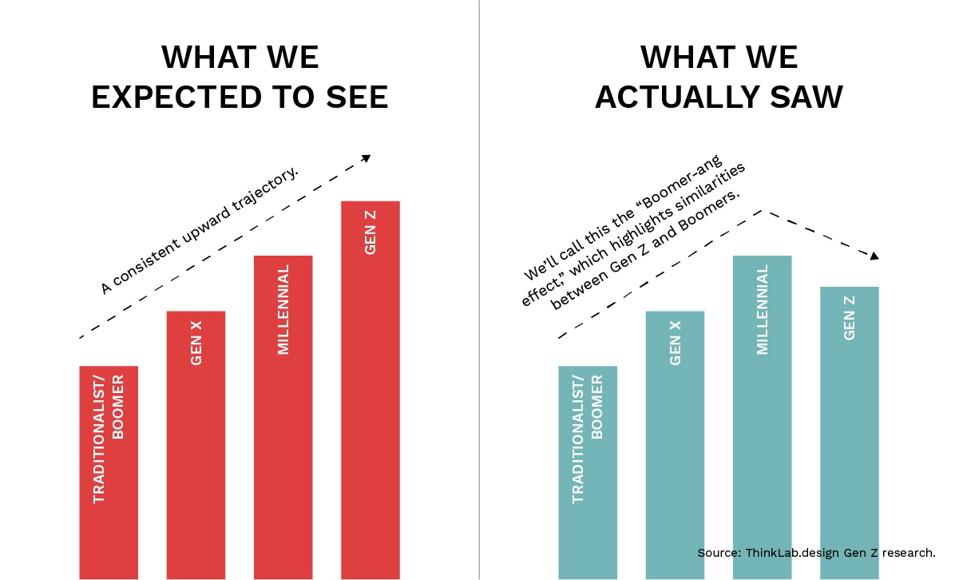Flexibility. Digital first. Hybrid.
Wherever you fall in the spectrum, one thing is certain: the great office debate is not ending in 2023. Yet with leases expiring, companies growing and changing, many business leaders are forced to make decisions for their office space before the future is crystal clear.“As innovation in tech continues to accelerate and new digitally native generations of employees join the ranks, the effectiveness of how we connect, regardless of location, will evolve. And the need to be physically together will continue to be brought into question,” says Julie Whelan, CRE Global Head of Occupier Thought Leadership & Research Consulting at CBRE.
So how do we maximize our investment in our people and our space? The good news is, we can find clues for the future by looking at the next generation. As I’ve mentioned in a previous article, “When thinking of Gen Z, it’s likely you would compare them to Millennials. In some ways, you are right. Both being digitally savvy, they are the people you call—or text because they won’t answer the phone—when you can’t figure out how to send a PDF. But in reality, Gen Z and Millennials are very different. In terms of attitudes toward money, privacy and success, Gen Z has a lot more in common with their grandparents and great-grandparents making them Old Souls in Young Bodies™.”
New data and insight on Gen Z from ThinkLab, the research division of Interior Design Magazine, echoes the idea of Old Souls in Young Bodies™and gives us ways to rethink how we leverage physical space to build culture. In fact, the data shows that in many cases Gen Z preferences align more closely with Gen X or Boomers:
In an era where remote work and digital communication have become the norm, Gen Z’s desire for a blend of physical and digital experiences may seem paradoxical. However, it reflects their need for meaningful connections and opportunities for growth. The office of the future, therefore, must adapt to these evolving preferences to attract and retain this generation of talent. It seems the office will become one very important tool in the toolkit, but not the only place culture can be built.
How to Make Your Office Space Everything it Needs to Be
Gen Z , or Zoomers as some fondly call them, will drive not only the evolution of the ‘office’ but also the evolution of ‘work’ for the next few decades,” said Deirdre Jimenez, President & CEO BIFMA (Business and Institutional Manufacturer’s Association)
The good news is, we have five research-backed ideas from ThinkLab’s latest Gen Z study that will prompt teams of all generations to want to connect in physical space:
Embrace the “Phygital” Experience
Gen Z’s affinity for the digital world is undeniable, but it doesn’t mean they want to abandon the physical realm. They seek a “phygital” experience—a seamless integration of physical and digital interactions. Companies that can strike the right balance by leveraging technology to enhance in-person experiences are more likely to engage Gen Z employees effectively.
Cheryl S. Durst, International Interior Design Association Executive Vice President and CEO, said, “We are seeing workplace interior designers focus strongly on experiential design—creating not just a place for focused work, or collaboration, but true experiences that use technology to offer customization and adaptability.”
Create Purposeful Face Time
While Gen Z values face-to-face interactions, they are discerning about how they spend their time. Gone are the days when a ping-pong table or a beanbag chair sufficed as workplace perks. Gen Z expects meaningful connections and opportunities for personal and professional growth. Companies should create environments that make the commute to the office worthwhile, fostering mentorship and collaborative spaces that align with their expectations.
The top three ways people feel engaged at work are:
1. Supportive coworkers
2. A fun work environment
3. Recognition (for Gen Z and Millennials especially).
Evolve Traditional Mentorship Programs
Traditional mentorship programs may not fully resonate with Gen Z. While they value guidance, they also seek peer-to-peer learning experiences. Forward-thinking companies should reframe their mentorship initiatives to encompass diverse learning approaches, such as collaborative projects and knowledge sharing platforms that cater to Gen Z’s fast-paced learning style.
Redefine Exposure
For Gen Z, visibility and recognition hold great importance. However, their concept of visibility differs from previous generations. Companies should rethink how they offer exposure opportunities, considering innovative career paths and diverse learning opportunities that align with Gen Z’s unique learning styles and aspirations. “See and be seen” now includes the physical and digital realms.
Empower Gen Z Voices
To retain and empower Gen Z employees, companies must create inclusive environments where their voices are not only heard but acted upon. One-size-fits-all policies won’t suffice. Instead, organizations should actively engage with their youngest talent, encouraging them to contribute ideas and take ownership of projects. This not only fosters a sense of belonging but also unlocks the full potential of Gen Z’s innovative thinking.
The great office debate will persist beyond 2023, but by understanding these five evolving preferences we can guide our decisions to maximize the use of our workplace; many of which have nothing to do with physical space at all. By adapting to the expectations of Gen Z, organizations can not only attract top talent but also foster a workplace culture that is future-ready and inclusive for all generations.

